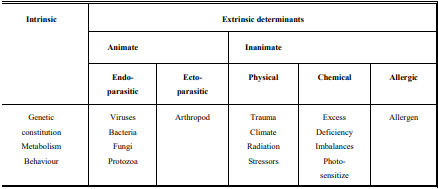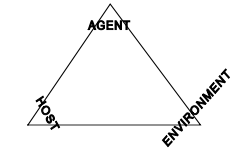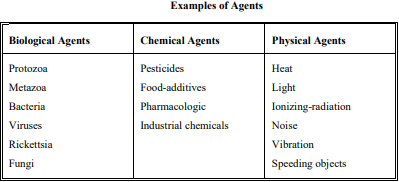TV4001 - Epidemiology 1
1/44
There's no tags or description
Looks like no tags are added yet.
Name | Mastery | Learn | Test | Matching | Spaced |
|---|
No study sessions yet.
45 Terms
Epidemiology is the study of?
disease in populations and of factors that determine its occurrence, the key word being populations
Endemic means?
May also refer to?
Usual presence of a disease within a geographic area
The usual prevalence (number of cases) of a disease within a geographic area
Epidemic means?
Disease within a geographic area in excess of the normal expectancy (the endemic level), and transmitted either from a common (single) source or from sources propagated from a single source
Pandemic means?
epidemic that affects several countries or continents or much of the world.
Five objectives of epidemiology are?

The acceptance of Koch's postulates by the scientific community resulted in a stereo-type line of thinking that lasted into the 1960s, that being?
More recent thinking has once more recognised the concept that disease is? What are these factors?
Each disease had a single cause and thus a suitable control strategy is directed at that causal agent
Usually caused by multiple factors.
These factors are determinants of disease. A determinant is any characteristic that affects the health of a population
Determinants can be classified in 3 ways, as?
1. primary or secondary;
2. intrinsic or extrinsic;
3. associated with host, agent or environment.
Primary vs Secondary Determinents
Difference between the two?
Primary: Factors that exert major influence on causing disease, often a necessary cause for disease
Secondary: correspond to predisposing, enabling or reinforcing factors
Primary Determinants Example Table

Secondary Determinants Example Table

Intrinsic vs Extrinsic Determinants
(Primary and Secondary Determinants can be intrinsic or extrinsic)
Intrinsic: Internal to the host (aka endogenous)
Extrinsic: External to the host (aka Exogenous)
The triad consists of what?
How does it work?
The Host, Agent and Environment
Early emphasis on microbes as primary disease causes made them be separated from other factors such as husbandry, trauma and toxic agents (environmental factors)

The Host, Agent and Environment triad:
Recently there has been a fourth category considered for what type of industry?
Why?
Intensive animal farming
Management and husbandry are considered to be important enough to be separated from the environemtn into its own category
The Host, Agent and Environment triad - What is a simple disease?
Examples?
An agent is the main determinant, and host and environmental factors are of relatively minor importance
Acute toxicities like arsenic or strychnine poisoning, where a multifactorial nature is not obviou
The Host, Agent and Environment triad - What is a complex disease?
Examples?
Disease where multifactorial nature dominates - interaction btw host, agent and environment necessary to cause disease
Bovine Respiratory Disease Complex
The Host, Agent and Environment triad
Agent Factors
Causative (etiologic) agents are not limited to biological agents; they may also be?
Chemical or Physical
The Host, Agent and Environment triad
Agent Factors Table
Examples for Biological Chemical and Physical Agents

The Host, Agent and Environment triad
Host Factors
Why are they important?
Examples of Host Factors?
They affect the risk of exposure to infection source AND host’s resistance to disease

The Host, Agent and Environment triad
Environmental Factors
The infectious disease process
Infectious disease results from the interaction of the agent, host, and environment in a process
which involves six components, what are they?
1. Causative agent
2. Reservoir of the agent
3. Portal of exit of the agent from the host
4. Mode of transmission of the agent to a new host
5. Portal of entry into the new host
6. Host susceptibility
The infectious disease process
Causative Agent
There are five basic categories of biological or etiologic agents. They are?
Those agents that are capable of causing disease are termed?
Factors that enhance ability to cause disease include?
The capacity of these agents to infect and to produce subsequent disease is called? What does it manifest as?
Protozoa
Bacteria & Rickettsia
Viruses & Prions
Fungi
Metazoa
Pathogens
Host specificity, ability to survive or multiply outside the host, and virulence
Pathogenicity
Manifest as signs and symptoms
The infectious disease process
Causative Agent
The severity of apparent infections is measured in terms of?
morbidity and mortality
The infectious disease process
Reservoirs of the Agent
What is this?
The two major categories of sources of infection are?
What does each mean?
Reservoir = normal habitat where agent lives, grows and multiplies (human, animal, environment)
Acute clinical cases and carriers.
Acute Clinical Cases
Transmission less likely as less contact and early diagnoses and specific TX
Carriers
Animal/human harbours infectious agent with no clear signs/symptoms
The infectious disease process
Reservoirs of the Agent
Carriers may be characterized as?
Significance of carriers?
inapparent infections, incubatory, convalescent, or chronic
More risk of disease transmission as contacts unaware of infection presence
The infectious disease process
Reservoirs of the Agent
Carrier classes and descriptions?
Inapparent infections (subclinical cases) - Infection but no symptoms
Incubatory Carriers - Can spread infection prior to disease symptoms
Convalescent Carriers - Remain infectious after acute illness and are now “healthy”
Chronic carriers - Harbour infectious agent 1+ yrs
The infectious disease process
Reservoirs of the Agent
Environment aspect?
Plants, soil, and water in the environment can be reservoirs of infection
The infectious disease process
3. Portals of exit of the agent from the host
What is it?
Different paths with examples?
Path where agent leaves the host = portal of exit
Resp tract - enzootic pneumonia
Genitourinary tract - Transmissable venereal tumours
Alimentary tract - Rabies, Salmonella
Skin - Smallpox
Transplacental - Rubella, Hepa B
The infectious disease process
4. Modes of transmission of the agent to a new host
Classes anf Examples?
Vertical Transmission - Via placenta or milk to next gen e.g. Toxocara canis and Akabane virus
Horizontal Transmission - from one individual to another, two forms (direct/indirect)
The infectious disease process
4. Modes of transmission of the agent to a new host
Horizontal - Direct vs Indirect Transmission?
Direct
Immediate via contact or droplet spread
Agents with this method - ideal to separate the diseased animal/environment
Indirect
Via animate/inanimate mechanisms
Animate - vectors like fleas
Inanimate - Spread via air or vehicles (fomites)
The infectious disease process
5. Portals of entry into the new host
Describe it
Same as portals of exit, disease may use different ones on entry/exit or the same one
The infectious disease process
6. Host susceptibility
Host resistance to disease is increased to the greatest extent by?
Specific acquired immunity either Natural or Artificial
Natural - Obtain protective ABs from getting infection (active) or transplacental transfer (passive)
Artificial - Admin of vaccines/toxoids (active) or Antitoxins/Immune serum globulin (passive) to get ABs
Prevention vs control vs eradication
Prevention is the first line of defence against a disease. It occurs at three levels:
Give an example for each
National - quarantine stations for livestock
Provincial/State - certification for transport that states free from certain disease
Local - separation of sick animals, maintain disease free herd
Prevention vs control vs eradication
Prevention of disease
Governmental agencies are usually involved in?
Foreign Animal Diseases are controlled at a variety of levels, those being?
Excluding pathogens from an area it is absent
1) Import requirements and health certificates.
2) Quarantine stations.
3) Veterinarians must recognise and report the disease.
Prevention vs control vs eradication
Protecting a specific population from a disease that already occurs can be achieved by?
Immunisation
Chemoprophylaxis
Environmental sanitation
Vector control
Genetic engineering and selective breeding
Early detection and DX
Public awareness and education
Prevention vs control vs eradication
Control of disease
Disease control is a term used to describe?
There are four approaches to control, what are they?
Measures done to dec freq of illness already in a population to what is considered an acceptable level
Preventing the spread of disease - intervene at the weakest pt of organism lifecycle
Dec communicability
Inc resistance
Early detection and DX
Prevention vs control vs eradication
Control of disease
decreasing communicability methods include?
Isolate the sick
Segregation practises - separate the at-risk
Quarantine - control movement if they have been exposed to disease but are healthy
Environmental control - disinfection, pasture rotation, manure disposal, etc
Prevention vs control vs eradication
Control of disease
Inc resistance how?
Active immunisation, passive immunity
Chemoprophylaxis - Note: Preventative TX can cause organism resistance and drug residues in food products
Prevention vs control vs eradication
3. Eradication of disease
Eradication of a veterinary disease involves?
Selective slaughter - kill infected, protect majority
Depopulation
Quarantine
Mass TX
Mass immunisation
Prevention vs control vs eradication
3. Eradication of disease
When is depopulation used?
a) A diagnostic test cannot be applied to an affected population in order
to carry out selective slaughter.
b) The population is inaccessible to perform other measures.
c) The disease is spreading too rapidly to control by other methods.
d) There are no other control methods available and depopulation of a
specific group is the only way to protect the species as a whole
Prevention vs control vs eradication
3. Eradication of disease
Use of mass TX depends on?
safe and cheap chemotherapeutic agents and early detection and diagnosis
Prevention vs control vs eradication
3. Eradication of disease
Which procedure is most effective of directed action against disease?
Mass immunisation
Prevention vs control vs eradication
3. Eradication of disease
Issues with selective slaughter?
How is it oft implmented?
Monetary costs outweigh benefits due to high involvement of animals
Disrupted economy
Unavailability of replacing animals
Mass immunisation then selective slaughter
To vaccinate or not to vaccinate
When should eradication be considered over using a biological product i.e. vaccine?
incidence of disease is low, the technology for eradication is present, and the industry support is available
To vaccinate or not to vaccinate
It is important to know whether or not the vaccine will further the chances of spreading disease due to?
reversion to virulence (in the case of a modified live vaccine) by creating carriers
To vaccinate or not to vaccinate
If safe and effective biological products are available their use should be considered if?
1) Incidence is widespread or increasing in spite of present control measures.
2) The technology to eradicate is not available.
3) It does not cause subclinical or carrier states and does not interfere with disease detection.
4) The disease is endemic